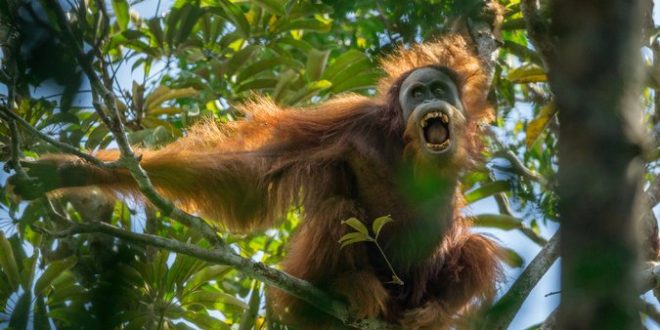Sumatra A new species of orangutan has been identified, and at the same time classified as one of the planet’s most endangered great apes.
With only around 800 remaining individuals occuring in upland forest regions of North Sumatra.
Two species of Indonesian orangutans had previously been officially described and recognized – the Pongo abelii, living on the island of Sumatra, and the Pongo pygmeaeus, endemic to Borneo. In 1997, researchers at the Australian National University discovered an isolated population of orangutans in Batang Toru, a region within the three Tapanuli districts in North Sumatra. UZH anthropologists working together with an international research team have now established that these orangutans are actually a distinct third species, Pongo tapanuliensis. The study carried out by the UZH researchers is the largest genomic study of wild orangutans to date.
Unique teeth and skulls
The first indications of the uniqueness of the Tapanuli population came from the skeletal material of an adult male orangutan killed in 2013 – when compared to other skulls it turned out that certain characteristics of the teeth and skull of the Tapanuli orangutan were unique. “We were quite surprised that the skull was quite different in some characteristics from anything we had seen before,” explains Matt Nowak, who researched the morphological characteristics as part of his PhD thesis and now works for the Sumatran Orangutan Conservation Programme (SOCP).
Three evolutionary lineages identified
“When we realized that the Tapanuli orangutans were morphologically different from all other orangutans, the pieces of the puzzle fell into place,” adds Michael Krützen, Professor of Evolutionary Anthropology and Genomics at UZH. Krützen and his team have been researching the genetic lineage of all living orangutan populations for some time. Previous study results combined with the new genome sequencing of 37 orangutans showed a picture that was consistent with the morphological findings: “We identified three very old evolutionary lineages among all orangutans, despite only having two species currently described,” says Maja Mattle-Greminger, a postdoctoral researcher at UZH.
Direct descendants of the first orangutan population
Extensive computer modelling aimed at reconstructing the history of the population enabled the UZH researchers to verify their new findings. Their calculations show that the Tapanuli population appears to have been isolated from all other Sumatran populations of orangutans for at least 10,000 to 20,000 years. Alexander Nater, who completed his PhD at UZH, explains: “The oldest evolutionary line in the genus Pongo is actually found in Tapanuli orangutans, which appear to be direct descendants of the first Sumatran population in the Sunda archipelago.” In addition, behavioral observations and ecological surveys support the genetic and morphological analyses.
Species conservation the top priority
“It is very exciting to discover a new great ape species in the 21st century,” says the principal author of the study Michael Krützen, although he cautions that the highest priority must now be to protect the Tapanuli orangutan. “All conservation efforts must focus on protecting the species’ environment,” stresses Krützen. More and more rainforest is being lost to agricultural use – virgin forests in the Batang Toru ecosystem are giving way to palm oil plantations, and there are also plans for the construction of a hydroelectric dam which would further intrude on the Tapanuli orangutans’ environment.
A recent survey carried out independently by Indonesian and international scientists indicated that no more than 800 individuals of the Tapanuli population remain, making the Tapanuli orangutan the great ape species at greatest risk of extinction. “If steps are not taken quickly to reduce current and future threats and to conserve every last remaining bit of forest, a great ape species may become extinct within a few decades,” warns Matt Nowak, who supervises research into the Tapanuli orangutans at the Sumatran Orangutan Conservation Programme.
Agencies/Canadajournal
 Canada Journal – News of the World Articles and videos to bring you the biggest Canadian news stories from across the country every day
Canada Journal – News of the World Articles and videos to bring you the biggest Canadian news stories from across the country every day



